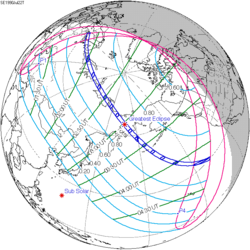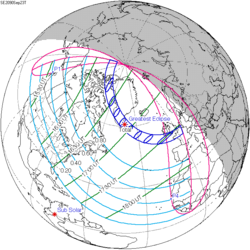| Total eclipse | |
| Gamma | −0.7512 |
|---|---|
| Magnitude | 1.0592 |
| Maximum eclipse | |
| Duration | 321 s (5 min 21 s) |
| Coordinates | 25°12′S9°30′W / 25.2°S 9.5°W |
| Max. width of band | 294 km (183 mi) |
| Times (UTC) | |
| Greatest eclipse | 12:11:22 |
| References | |
| Saros | 146 (26 of 76) |
| Catalog # (SE5000) | 9491 |
A total solar eclipse occurred at the Moon's descending node of orbit on Tuesday, June 30, 1992, [1] with a magnitude of 1.0592. A solar eclipse occurs when the Moon passes between Earth and the Sun, thereby totally or partly obscuring the image of the Sun for a viewer on Earth. A total solar eclipse occurs when the Moon's apparent diameter is larger than the Sun's, blocking all direct sunlight, turning day into darkness. Totality occurs in a narrow path across Earth's surface, with the partial solar eclipse visible over a surrounding region thousands of kilometres wide. Occurring about 1.5 days before perigee (on July 2, 1992, at 1:30 UTC), the Moon's apparent diameter was larger. [2]
Contents
- Observations
- Images
- Eclipse details
- Eclipse season
- Related eclipses
- Eclipses in 1992
- Metonic
- Tzolkinex
- Half-Saros
- Tritos
- Solar Saros 146
- Inex
- Triad
- Solar eclipses of 1990–1992
- Saros 146
- Metonic series
- Tritos series
- Inex series
- Notes
- References
Totality was visible in southeastern Uruguay and southern tip of Rio Grande do Sul, Brazil. A partial eclipse was visible for parts of central South America, West Africa, Central Africa, and Southern Africa.



































































































